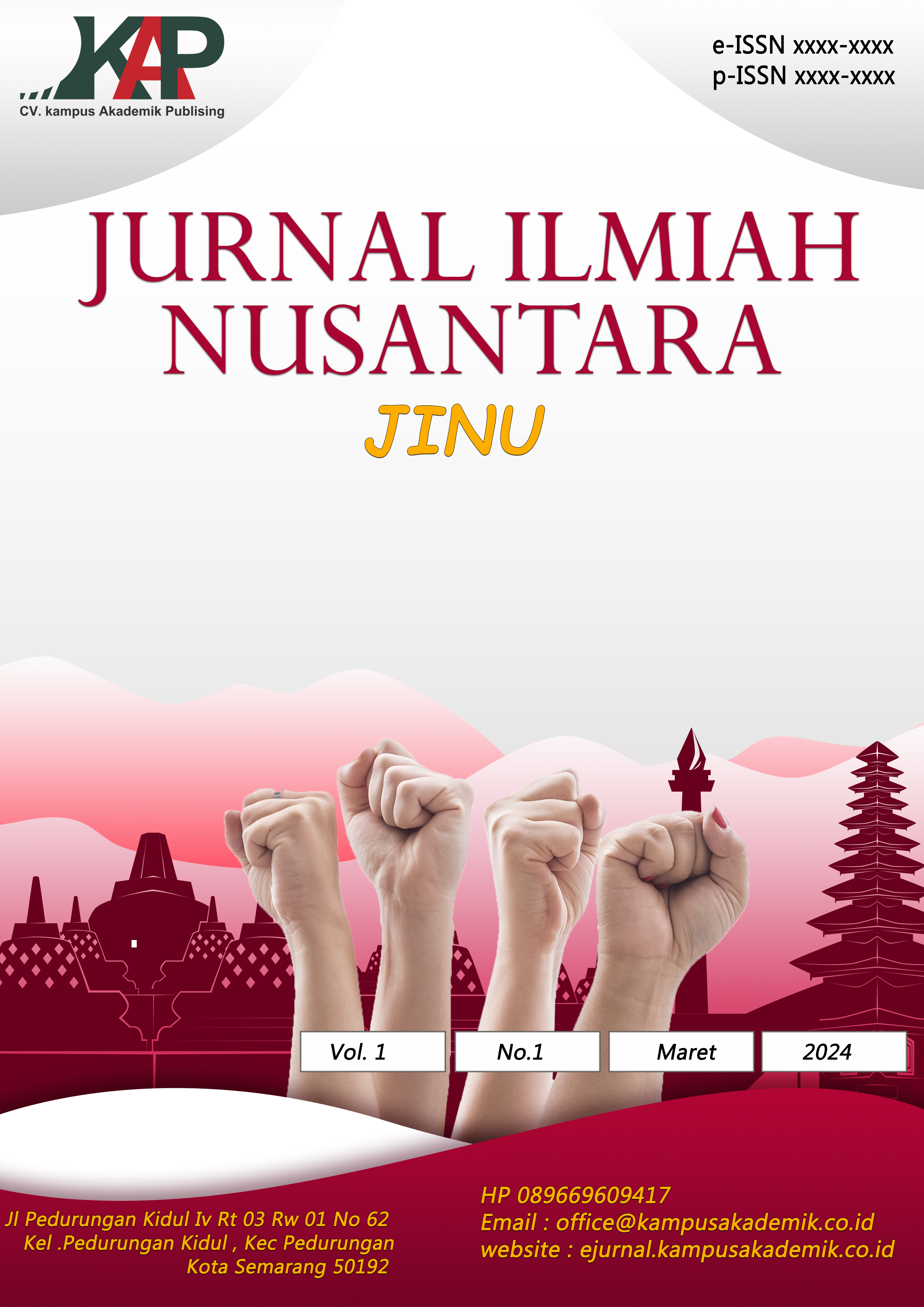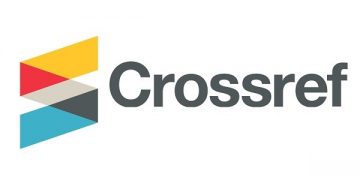KORELASI ANTARA PEMAHAMAN KITAB SAFINATUN NAJAH DENGAN PRAKTIK IBADAH SHALAT SISWA KELAS VIII MTs MA'ARIF GONDANG WATUMALANG
DOI:
https://doi.org/10.61722/jinu.v2i4.5154Keywords:
Correlation, Understanding, Worship PracticeAbstract
The objectives of this research are: 1) To determine the students’ understanding of the book Safinatun Najah in grade VIII at MTs Ma’arif Gondang; 2) To assess the students’ practice of prayer in relation to their understanding of the book Safinatun Najah; 3) To identify the correlation between the understanding of Safinatun Najah and the students’ practice of prayer.This study is a field research using a quantitative correlational approach. Data collection techniques include observation, testing, and documentation. To test the hypothesis, the researcher used the Product Moment correlation formula. The sampling technique used was total sampling, where the number of samples equals the population, namely 68 students.The results of the study show that: (1) The understanding of Safinatun Najah among grade VIII students at MTs Ma’arif Gondang Watumalang falls into the “good” category with an average score of 78.27; (2) The result of the prayer practice test for grade VIII students at MTs Ma’arif Gondang Watumalang also falls into the “good” category with an average score of 88.11; (3) The correlation result between the understanding of Safinatun Najah and prayer practice shows a Product Moment test score of 0.389 with a significance level of 0.001. This is proven by the empirical correlation coefficient (r-count) = 0.389, which is greater than the Pearson Product Moment table coefficient at the 5% significance level = 0.2387 and at the 1% significance level = 0.3104. Thus, the hypothesis proposed by the researcher is accepted, namely “there is a positive and significant correlation between the understanding of the book Safinatun Najah and the practice of prayer among grade VIII students of MTs Ma’arif Gondang Watumalang.”
References
Abdidn, Z. (2020). Fiqh Ibadah. Yogyakarta: Deepublish.
Abdillah, I. (2017). Mukjizat Ibadah:Dimana Ibadah Bukan Hanya Sekadar Kewajiban. Jakaarta: 16.
Abdurrahman, S. A. (2011). Analisis Korelasi Regresi dan Jalur dalam Pendidikan. Bandung: Pustaka Setia.
al-Hadhrami, S. S. (2017). Mutiara Hikmah Fiqih Favorit Terjemah Safianah an-najah. Kediri: Lirboyo Press.
al-Hadhrami, S. S. (n.d.). Safinatun Najah. Surabaya: Alhidayah.
Al-Hadhromi, S. S. (2017). Mutiara Hikmah Fiqih Favorit Terjemah Safinah An-Najah. Kediri: Liboyo Press.
al-Jaziri, A.-R. (1990). al-Fiqh ala al-Mazahib al alarba'ah. Beirut: Dar al-Kutubal-Ilmiyah.
Anwar, C. (2017). Teori-Teori Pendidikan Klasik Hingga Kontemporer. Yogyakarta: IRCiSoD.
Arfan, A. (2011). Fiqih Ibadah Praktis. Malang: UIN MAliki Press.
Arikunto, S. (2006). Prosedur Penelitian sebuah Pendekatan Praktik Edisi Revisi. Jakarta: Rineka Cipta.
Arikunto, S. (2009). Dasar-Dasar Evaluasi Pendiddikan. Jakarta: PT Bumi Aksara.
Ash-Shiddieqi, M. H. (2010). Kuliah Ibadah. Semarang: Pustaka Rizki.
As-Shidiqiey, T. M. (2000). Pedoman Shalat. Semarang: Pustka Rizki Putra.
Azri, F. A. (2011). Shalat Seusai Tuntunan Nabi SAW. Yogyakarta: Nuha Lentera.
az-Zuhaili, W. (2011). al-Fiqh al-Islami wa Adillatuhu. Jakarta: Gema Insani Press.
Bahasa, P. P. (1990). Kamus Besar Bahasa Indonesia. Jakarta: Balai Putaka.
Bloom, B. s. (2009). Taksonomi Tujuan-Tujuan Pendidikan : Domain Kognitif" terj Tim Penerjemah. Yogyakarta: Pustaka Pelajar.
Bloom, B. S. (2009). Taksonomi Tujuan-Tujuan Pendidikan:DOmain Kogntof, terjemah oleh Tim Terjemah. Yogyakarta: Pustaka Pelajar.
Bloom, B. s. (2015). Pengantar Evaluasi Pendididkan. Jakarta: Rajawali Pers.
Dahlan, Y. W. (2007). Terjemahan Kitab Safinatun Najah, Fiqih Ibadah Praktis dan Mudah Terjemahan dan Penjelasan. Kudus: Menara Kudus.
Haryanto, S. (2022). sikologi Shalat (Kajian Aspek-Aspek Psikologis Ibadah Shalat) Cet. II. Yogyakarta: Pustaka Pelajar.
Islam, P. P. (1983). Fikih. Jakarta.
Marogono, D. (2010). Metodologi Penelitian Pendidikan. Jakarta: Rineka Cipta.
Mughiyah, M. J. (1995). Fiqih Ja'fari. Jakarta: Lentera.
Mustofa, B. (2007). Menjadi Sehat denga Shalat. Yogyakarta: Optimus.
Naja, D. (2019). Bekan Bankir Syariah. Jawa Timur: Uwais Inspirasi Indonesia.
RI, D. A. (2005). Al-Qur'an dan Terjemahannya. Jakarta: PT Syaamil Cipta Media.
Ri, U. (2008). Tentang SISDIKNAS dan Wajib Belajar. Bandung: Citra Umbara.
Rusdiana, E. R. (2015). Evaluasi Pembelajaran. Bandung: CV Pustaka Setia.
Sahriansyah. (2014). Ibadah dan Akhlak. Yogyakarta: IAIN Antasari.
Saleh, H. (2008). Kajian Fiqih Nabawi & Fiqih Kontemporer. Jakarta: Pustaka Pelajar.
Siregar, S. (n.d.). Statistik Parametrik untuk Penelitian Kuantitatif Dilengkapi dengan Perhitungan manual Aplikasi SPSS versi 17.
Slamerto. (2010). Belajar dan Faktor-Faktor yang mempengaruhinya. Jakarta: Rineka Cipta.
Sudaryono. (2012). Dasar-Dasar Evaluasi Pembelajaran. Yogyakarta: Graha Ilmu.
Sudjana, N. (2010). Penilaian Hasil Proses Belajar Mengajar. Bandung: PT Remsjs Rosdakarya.
Sugiyono. (2013). Metode Penelitin Pendidikan, Pendekatan Kuantitatif, Kualitatif, dan R&D. Bandung: Alfabeta.
Sugiyono. (2019). Statistik untuk Penlitian. Bandung: Alfabeta.
Sukmadinata, P. D. (2005). Metode Penelitian Pendidikan. Bandung: Rosdakarya.
Thoha, C. (1996). Metodologi Pengajaran Agama. Yogyakarta: Pustaka Pelajar.
Zainal Abididn, A. d. (2020). Efektivitas Pembelajaran Jarak Jauh Pada Masa Pandemi Covid-19. journalofeducation, 9.
Downloads
Published
Issue
Section
License
Copyright (c) 2025 JURNAL ILMIAH NUSANTARA

This work is licensed under a Creative Commons Attribution-ShareAlike 4.0 International License.













